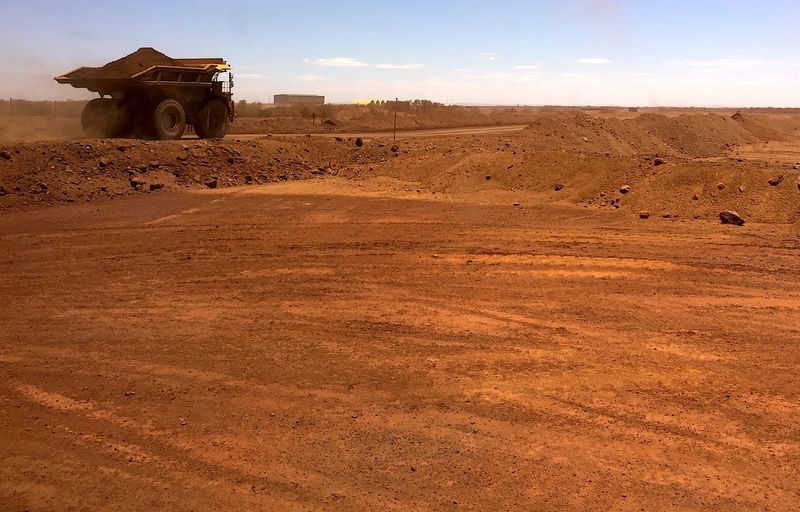SYDNEY/MELBOURNE (Reuters) – In the world’s biggest iron ore loading hub, Western Australia’s Port Hedland, huge vessels line up near the red-dirt coast, waiting to be loaded with the sought-after steel-making material.
Further south, the state’s wheatbelt has started planting the year’s main crop, buoyed by high grains prices and global demand for flour.
With its commodities sector suffering only minor disruptions from the coronavirus, Western Australia is currently one of the world’s few bright spots, even as the wider national economy faces its first recession in three decades.
Graphic – Map showing bulk vessel traffic from Port Hedland on May 4, 2020: https://fingfx.thomsonreuters.com/gfx/ce/yzdvxonezpx/PortHedlandMap.png
Economists, miners and farmers believe global demand for food and iron ore will mark a return to prosperity for a region that fell into the doldrums in 2014.
Farmer Lyndon Mickel recently started planting wheat on his 6,000 hectare property near Esperance in the state’s southern wheatbelt. He sees “business as usual” with good selling prices for grains in the past month.
“Someone needs to maintain that supply of produce for home cooking and wheat for pasta – and it may as well be us,” Mickel said.
Australia is one of the world’s largest wheat producers with Western Australia’s grain exports accounting for roughly 40% of the national total. Strong global prices are partly due to Russia, another major producer, curbing exports due to concerns about a domestic shortage.
Australia, like other countries, closed its borders and shut down almost all domestic travel in March to halt the local coronavirus spread.
Those measures appear to have worked with the national new infection rate now below 1% from a peak of about 25%. Australia has recorded around 6,800 infections and 96 deaths.
Western Australia has succeeded in stopping almost all new infections.
Analysts now expect the state to lead a national recovery.
“Western Australia is less dependent on international tourism, which will be the last thing to come back. It is a massive provider of iron ore and prices have held up,” AMP Capital chief investment strategist Shane Oliver told Reuters.
While public finances in other states and at a federal level are expected to deteriorate, as revenues plunge and spending balloons, Western Australia is expected to maintain a balanced budget, economists say.
Fuelling export demand is China’s own cautious emergence from the economic paralysis caused by the outbreak.
Australia’s government in March forecast iron ore exports worth A$101 billion ($65.1 billion) in the financial year ending June 30, up from $79 billion a year earlier.
Iron ore prices have remained resilient, holding around $80-85 per tonne throughout the pandemic, backed by production cuts from Brazil’s Vale and export curbs elsewhere.
Prices are expected to hold up as governments spend on steel-heavy projects to revive growth.
Shipments are proceeding in full, said John Finch, general manager of operations at Australia’s Pilbara Ports, which channels the world’s biggest iron ore exports.
“March was our third highest throughput month ever. We haven’t missed a beat. The demand is very, very high and we still have the same 30 or 40 ships sitting off the port waiting to come in,” he told Reuters.
RECOVERY RISKS
A decade ago, while many countries were dealing with the global financial crisis, pubs in some West Australian boom towns were selling beer to highly paid mine workers at about twice the normal price seen elsewhere in the country.
That strong growth came to an end in 2014 as China’s industrial demand declined significantly, triggering a fall in local property prices.
Still, the state’s economy remains highly export-dependent with 80% of its agricultural production and almost all its ore sent overseas.
Overhanging its more upbeat outlook are several risks, including a possible second wave of infections.
Australia is also engaged in a hostile diplomatic dispute with Beijing over Canberra’s push for an international inquiry into the coronavirus, drawing threats of a trade backlash.
Broker Argonaut Securities warns iron ore prices could fall if there is a prolonged global slump in steel demand.
And while many West Australian farms have good sub-soil moisture, most are yet to receive a planting rain needed for a good harvest.
For now, however, real demand from China has given the state and wider national economy a much needed tailwind.
Last week, Fortescue Metals Group <FMG.AX>, the world’s fourth biggest iron ore miner, forecast record shipments.
“Our iron ore shipments have continued as planned…we’ve seen strong ongoing demand for our products,” Fortescue Chief Executive Elizabeth Gaines said.
(Reporting by Jonathan Barrett and Melanie Burton; Editing by Sam Holmes)













